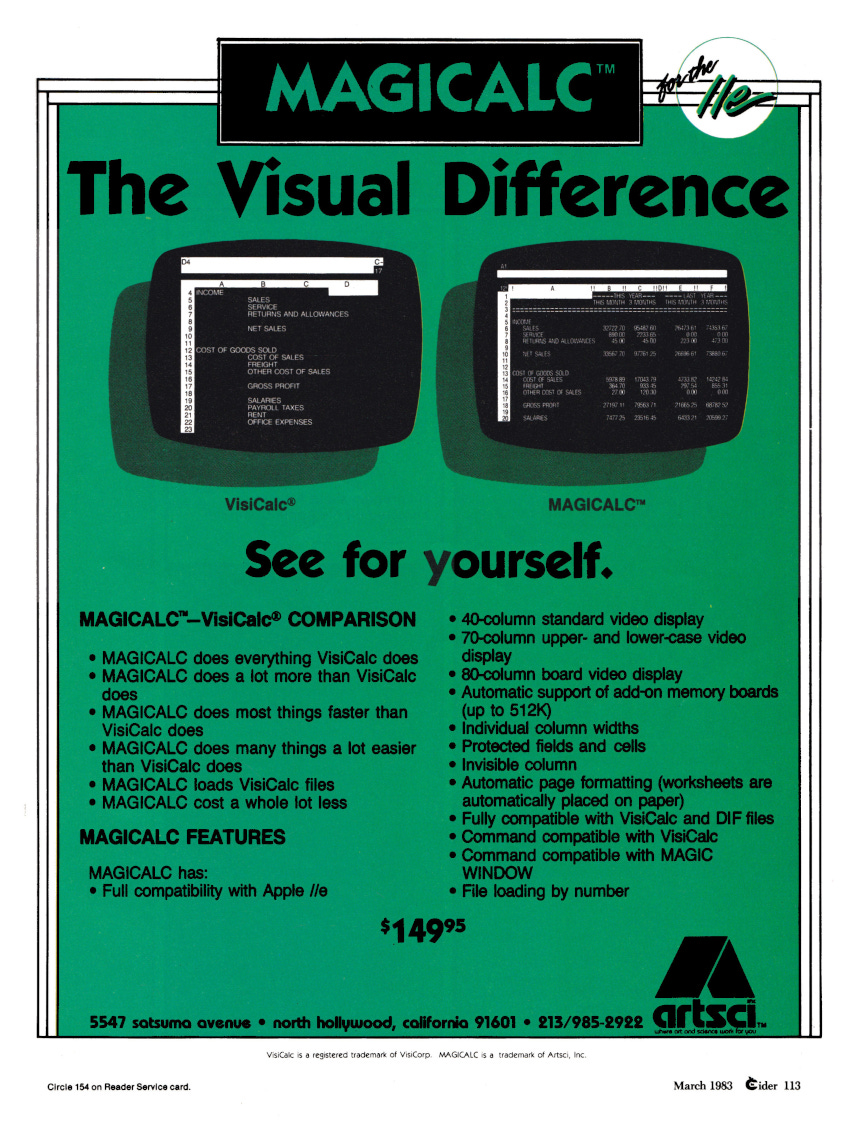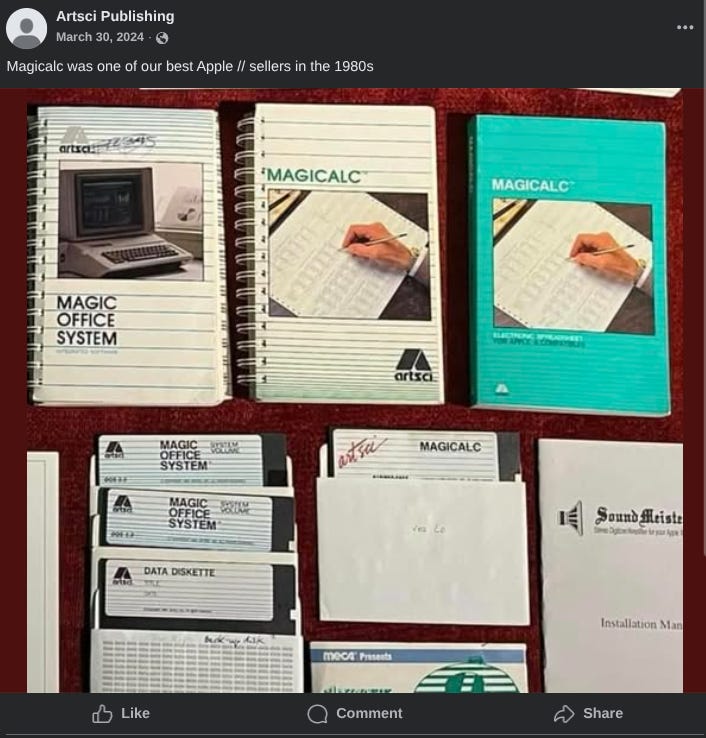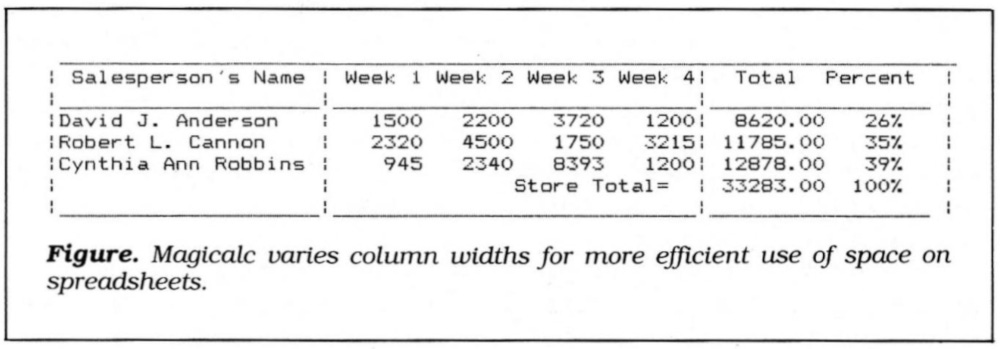Note: Sorry for the delay this month. I hit a deer with my car and have been looking for a replacement.
The Company
Artsci was founded in 1977 by William V. R. Smith, William DePew, and Gary Koffler under the name Softech. Smith and Koffler were Apple II fans, and DePew was a self-taught programmer. Together, their goal was to create and sell software for the Apple II.
A few months later, they were forced to rename the company to Softape because another company was using the name Softech. The company name was changed again in 1980 following Koffler’s departure. The company was named Artsci.
Besides creating and selling software, Softape/Artsci also published Softalk, a magazine covering everything related to the Apple II. The magazine ran from 1980 to 1984.
According to OpenCorporates, Artsci was dissolved in August 2001. However, Smith still operated the website, where he sells amateur radio books and equipment. He also has information about the Apple II days.
The Application
So what was MagiCalc? The December 1982 issue of Softalk described it thusly:
MagiCalc. by William Graves. An advanced new spreadsheet program that includes seventy-column upper and lower case video display (requires 64K), eighty-column board compatibility, individual column widths, invisible columns for confidential data, and full compatibility with VisiCalc files and functions. $149.95.
The 1983 issue of Peeling II examined 7 spreadsheet programs for the Apple II. This included a combined look at The Spreadsheet 2.0 and MagiCalc. The author explained that the two programs were in reality the same offering from two different sources. MagiCalc was available from Artsci, and The Spreadsheet 2.0 was available from Apple Pugetsound Program Library Exchange (or A.P.P.L.E.). One of the main differences between the two versions was the price ($60 vs $149). The review notes, “Both programs are of the format and intent of all of the electronic spreadsheet programs since VisiCalc first made personal computers popular.”
The review summary stated:
“Before purchasing THE SPREADSHEET 2.0 from A.P.P.L.E., I was a VisiCalc user. The following steps were required to bring up the program in the way I wanted to use it:
1. Boot normal DOS and run a program to load the Videx Function Strip.
2. Boot the Videx VisiCalc Preboot to allow VisiCalc to run in 80 columns.
3. Insert the protected VisiCalc disk and press RETURN to boot it.
With THE SPREADSHEET 2.0, only step 2 is missing since the program
Spreadsheet 2.0 & Magicalc has an 80-column capability. However, it is still a three-step process since the video configuration driver step is required each time. I still prefer my applications programs to be binary files that can be BRUN from a controlling menu or EXEC file. Not everybody needs or wants this ability, but to eliminate it detracts from the program's usability.
Error trapping within the program is excellent. I succeeded in bombing the program only once, and this was by doing an unnatural sequence of loading the Hi-Res graphics video driver. Error messages are clear and allow you to make appropriate corrections. The results of calculations I performed were accurate and reasonably fast.
If you are looking for a spreadsheet program and are an A.P.P.L.E. member, then look no further. THE SPREADSHEET 2.0 is your best buy. At $60.00 for the copyable program disk, the value received is great. At $149.95 for the protected Artsci disk, the value is somewhat less (considering that it only costs $45 to join A.P.P.L.E.) but still greater than purchasing comparable electronic spreadsheet programs that cost $250 or more. (Now if somebody would just come up with a driver for the Videx ULTRATERM card.”
The February 1984 issue of Creative Computing mentioned MagiCalc in their coverage of that year’s Applefest San Francisco:
Magicalc from Artsci is a second-generation spreadsheet. It can use most 80-column boards, but alone can display either 40 or 70 columns. Advanced features include varying width columns, invisible cells or columns, automatic formatting, and a user-friendly menu system. $149.95.
Artsci was showing several other packages in the Magic series. We were impressed with Magic Window II, successor to the original Magic Window. It shows the representation of a piece of paper on the screen just as you would see it in a typewriter— basically, what you see is what you get. The cursor motion and editing commands provide all we could imagine plus some of which we never dreamed. $149.95.
W. Charles Doherty wrote a review of MagiCalic in the September 1984 inCider (I love that name). Here are some selections:
“When VisiCalc brought the electronic spreadsheet to small computers, I felt I found the program of my dreams. For hundreds of applications, VisiCalc did the trick. Good as it was though, I found things that needed improvement. Not big things, perhaps, but annoying nonetheless.
Artsci, Inc., of 5545 Satsuma Avenue, North Hollywood, CA 91601, has introduced a program that made me move my trusty copy of VisiCalc to the back shelf. It is as if someone asked me what I would like to change about VisiCalc, and then wrote a program to my specifications. Magicalc, Artsci's new spreadsheet program, is the best I have seen near its price.
Artsci decided to enhance a proven format rather than re-invent the wheel. Magicalc is almost an exact duplicate of VisiCalc in terms of layout, command structure, and file format. If you have used VisiCalc, you could sit down with Magicalc and operate it without a hitch.
…
Cursor movement is very versatile with Magicalc. Along with standard cell-by-cell movement and direct GOTO commands, Magicalc's commands move the cursor up or down one half-screen at a time or directly to the beginning or end of the worksheet.
My favorite enhancement is the ability to set column widths individually. It aligns one column for eight figures without wasting the bulk of
another column that will never exceed two digits. Columns for percentages are easily mixed with longer figures anywhere on the display or printout. There are plenty of little tricks available thanks to this feature, such as filling a one-character wide column with a broken line to create a vertical divider. Not only are the spreadsheets produced with Magicalc neater looking than those made with other programs, it's possible to fit much more information into a lot less space…
Magicalc sells for $149 retail, and is $ 100 less than VisiCalc. I found it a better program all-in-all. I recommend Magicalc for any current spreadsheet user, as well as the first time buyer. It is flexible, easy to use, and surprisingly affordable.”
Have you ever used ArtSci MagiCalc? Do you know anything about its history? Tell us about it in the comments below.






